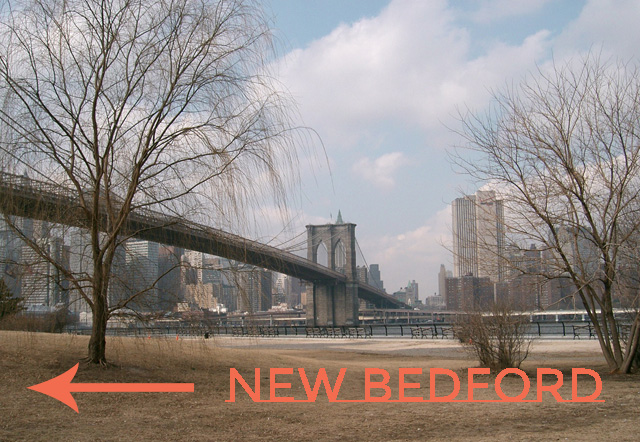Is New Bedford the Brooklyn of Massachusetts?

Any older post-industrial city faces its challenges. Whether it’s Detroit or Buffalo or New Bedford, the last 30 or 40 years have seen a steady decline in the old economic infrastructure that underpinned these places. Rapid suburbanization played a part, too.
Navigating a way forward in the new tech economy – while retaining a sense of identity tied to legacy industries like autos, manufacturing, textiles or fishing – hasn’t been easy, but it’s been steady in recent years. Each of these cities are on their own journeys to becoming what they once were again – regional hubs.
When the economic infrastructure of a city slips, so, too, does its civic infrastructure. Municipal government can become parochial and provincial as it struggles to adapt. Institutions grow stale. Public schools suffer. Grand projects whither or are postponed again and again. Like SouthCoast Rail.
But there’s another sort of infrastructure that can become stronger during these tough times. And, as New Bedford continues to vault forward – as it has in recent years – it’s important to acknowledge the importance of this other infrastructure to a place and the role it plays in sustaining cities like Detroit and Buffalo.
In New Bedford, this form of infrastructure runs deep.
It’s the emotional infrastructure of a city. The emotional infrastructure of a place like New Bedford can be found in the fierce attachment people feel towards the city. That emotion consists of nostalgia, romance and hope. And on that score, New Bedford ranks right up there with Brooklyn, NYC. In fact, it may qualify as the Brooklyn of Massachusetts.
We’re all from Brooklyn
Brooklyn is the type of place that, even if you’ve never set foot in the New York City borough, sounds like home to any urban person. With it’s diverse neighborhoods, working class history and vibrant street life, it’s what Manhattan only was in the movies. Brooklyn was – and in many places still is – the urban idyll. If you grew up in New Bedford, you know Brooklyn, too. It’s the quintessential city experience – writ large.
Like New Bedford and other places, the last half of the 20th century wasn’t easy for Brooklyn. But – it was always Brooklyn. Just as New Bedford has always been…New Bedford. Brooklyn, like New Bedford, meant authenticity. Brooklyn meant a melting pot of people who didn’t always get along easily but who all staked a claim to their Brooklyn.
Brooklyn means Coney Island to some and Crown Heights to others. Prospect Park and the Brooklyn-Queens Expressway. Elegant brownstones and public housing. Downtown, Ditmas Park, Greenpoint and being “Moonstruck” in Brooklyn Heights. It’s Nathan’s Hot Dogs and Gefilte fish – and neither is exactly delectable.
But, some people don’t get Linguiça, either.
The Romance of New Bedford
Like Brooklyn, New Bedford means different things to different people. It means the North End and Acushnet Avenue to some. Others will forever identify themselves with Brock Avenue and the Municipal Beaches of the South End. Or, the heart of the West End running up Kempton Street.
New Bedford means African-American, Cape Verdean, French, Irish, Polish, Portuguese and now Hispanic and Latino influences – each contributing to what the writer, Pete Hamill termed the “alloy” of a city in his book, Downtown.
And, oh yes, New Bedford has a downtown. It’s both a historic district – and a thriving center once again. That’s thanks to improved economic and civic infrastructure – built upon a passionate commitment to place by cultural warriors and creative leaders who poured their emotion down William Street.
New Bedford, of course, has a waterfront, too, that’s as emblazoned in the American consciousness as much as the Brooklyn Navy Yards. Nationalities of all types and colors contributed to its legend – and Herman Melville burnished it into the collective consciousness with “Moby-Dick.”
Finally, what Brooklyn and New Bedford really have in common is an abundance of emotional infrastructure. And that’s nothing to dismiss.
What Emotional Infrastructure means for the future
In Brooklyn now, that emotional infrastructure is being tested in new ways. Some actually fear the loss of “their” Brooklyn as it becomes more and more gentrified. We’re not there yet in New Bedford – but romance shouldn’t blind us to the fact that it could happen here, too.
As cities continue to rebound, and economic and civic infrastructure recovers along with them, it’s important to remember that part of what brought them back from the brink was the amount of emotional infrastructure they had in the bank.
You can’t put a price on that – but many will try to. It’s happened and is still happening in Brooklyn. The better aspects of the new economic infrastructure – like inclusive artist and coworking spaces at the Brooklyn Navy Yards or Industry City in Sunset Park – are a hedge against all out corporate assault in the form of Atlantic Yards (sic) and exclusionary luxury housing projects everywhere in the borough.
The people leading the fight against a takeover of Brooklyn are the people who understand its emotional infrastructure. We’ve got those same people here in New Bedford – and we need to listen to them going forward.
Right now, New Bedford still has an excess of emotional infrastructure. As its civic and economic infrastructure catches up in the next few years, that’s a useful reserve of goodwill to draw on as the city continues to chart a new course into the future.
It will always be its most valuable asset – if spent wisely.
- A Pride month to be proud of in New Bedford - May 30, 2019
- OUTTAKE: Inside the First Baptist Church renovation - May 2, 2019
- New Bedford Economic Development Council’s Spring Fling - April 30, 2019
